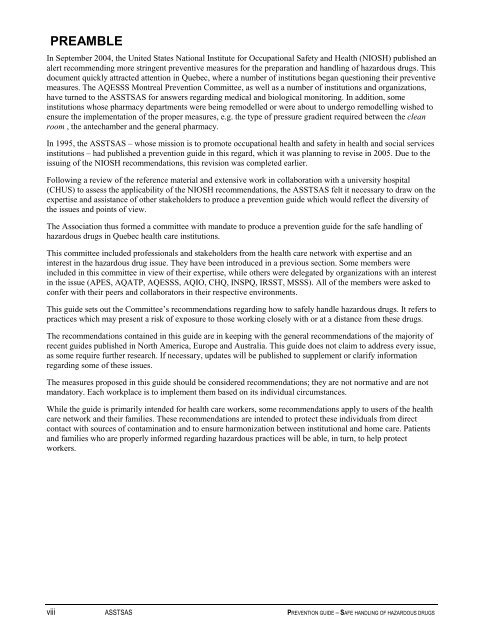Prevention Guide - Safe Handling of Hazardous Drugs - Irsst
Prevention Guide - Safe Handling of Hazardous Drugs - Irsst
Prevention Guide - Safe Handling of Hazardous Drugs - Irsst
Create successful ePaper yourself
Turn your PDF publications into a flip-book with our unique Google optimized e-Paper software.
PREAMBLE<br />
In September 2004, the United States National Institute for Occupational <strong>Safe</strong>ty and Health (NIOSH) published an<br />
alert recommending more stringent preventive measures for the preparation and handling <strong>of</strong> hazardous drugs. This<br />
document quickly attracted attention in Quebec, where a number <strong>of</strong> institutions began questioning their preventive<br />
measures. The AQESSS Montreal <strong>Prevention</strong> Committee, as well as a number <strong>of</strong> institutions and organizations,<br />
have turned to the ASSTSAS for answers regarding medical and biological monitoring. In addition, some<br />
institutions whose pharmacy departments were being remodelled or were about to undergo remodelling wished to<br />
ensure the implementation <strong>of</strong> the proper measures, e.g. the type <strong>of</strong> pressure gradient required between the clean<br />
room , the antechamber and the general pharmacy.<br />
In 1995, the ASSTSAS – whose mission is to promote occupational health and safety in health and social services<br />
institutions – had published a prevention guide in this regard, which it was planning to revise in 2005. Due to the<br />
issuing <strong>of</strong> the NIOSH recommendations, this revision was completed earlier.<br />
Following a review <strong>of</strong> the reference material and extensive work in collaboration with a university hospital<br />
(CHUS) to assess the applicability <strong>of</strong> the NIOSH recommendations, the ASSTSAS felt it necessary to draw on the<br />
expertise and assistance <strong>of</strong> other stakeholders to produce a prevention guide which would reflect the diversity <strong>of</strong><br />
the issues and points <strong>of</strong> view.<br />
The Association thus formed a committee with mandate to produce a prevention guide for the safe handling <strong>of</strong><br />
hazardous drugs in Quebec health care institutions.<br />
This committee included pr<strong>of</strong>essionals and stakeholders from the health care network with expertise and an<br />
interest in the hazardous drug issue. They have been introduced in a previous section. Some members were<br />
included in this committee in view <strong>of</strong> their expertise, while others were delegated by organizations with an interest<br />
in the issue (APES, AQATP, AQESSS, AQIO, CHQ, INSPQ, IRSST, MSSS). All <strong>of</strong> the members were asked to<br />
confer with their peers and collaborators in their respective environments.<br />
This guide sets out the Committee’s recommendations regarding how to safely handle hazardous drugs. It refers to<br />
practices which may present a risk <strong>of</strong> exposure to those working closely with or at a distance from these drugs.<br />
The recommendations contained in this guide are in keeping with the general recommendations <strong>of</strong> the majority <strong>of</strong><br />
recent guides published in North America, Europe and Australia. This guide does not claim to address every issue,<br />
as some require further research. If necessary, updates will be published to supplement or clarify information<br />
regarding some <strong>of</strong> these issues.<br />
The measures proposed in this guide should be considered recommendations; they are not normative and are not<br />
mandatory. Each workplace is to implement them based on its individual circumstances.<br />
While the guide is primarily intended for health care workers, some recommendations apply to users <strong>of</strong> the health<br />
care network and their families. These recommendations are intended to protect these individuals from direct<br />
contact with sources <strong>of</strong> contamination and to ensure harmonization between institutional and home care. Patients<br />
and families who are properly informed regarding hazardous practices will be able, in turn, to help protect<br />
workers.<br />
viii ASSTSAS PREVENTION GUIDE – SAFE HANDLING OF HAZARDOUS DRUGS

















